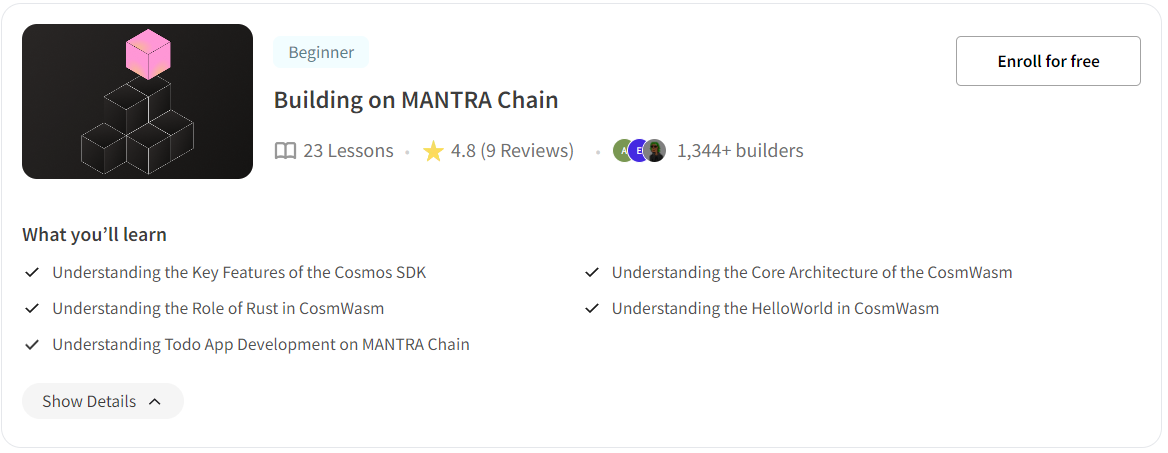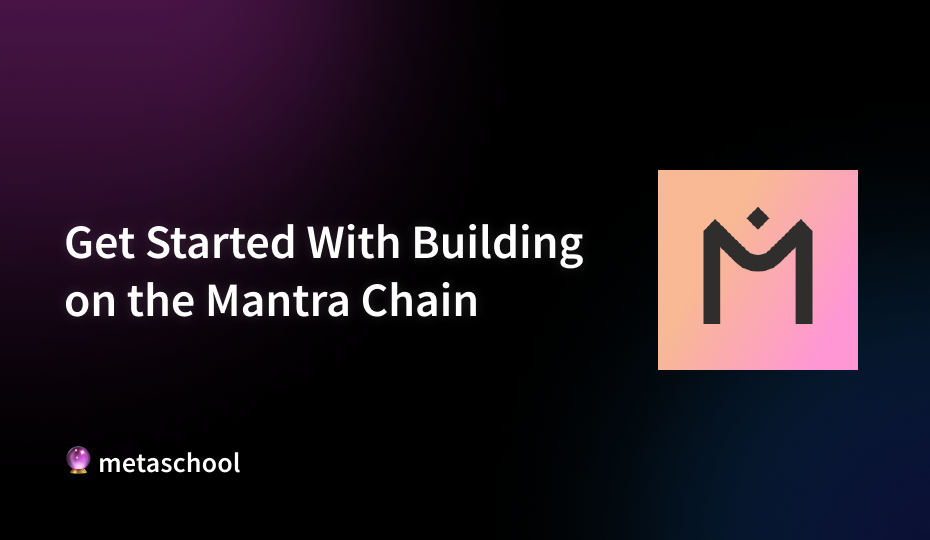Table of Contents
Mantra Chain is quickly emerging as a go-to blockchain platform for developers who want to build scalable, secure, and efficient decentralized applications (dApps). Whether you’re creating projects for DeFi, NFTs, or exploring new use cases in the decentralized web, Mantra Chain provides the tools and infrastructure to bring your ideas to life. With its Delegated Proof-of-Stake (DPoS) consensus mechanism, Mantra Chain ensures fast transactions and low fees, making it a highly efficient platform for developers.
This article will cover everything you need to get started with building on Mantra Chain. From understanding the core features of the blockchain to deploying your first dApp on its Testnet, this comprehensive guide will provide you with all the essential information. It will also introduce you to dedicated Mantra Chain courses available on Metaschool, and highlight the various builder incentives that make developing on Mantra Chain even more rewarding.
To discover more about Mantra Chain and how to get started with building on it, visit Mantra’s official website.
What is Mantra Chain?
Mantra Chain is a high-performance, interoperable blockchain platform designed to provide developers with the tools they need to build decentralized applications (dApps) in a scalable, secure, and efficient environment. Powered by a Delegated Proof-of-Stake (DPoS) consensus mechanism, Mantra Chain is focused on offering faster transaction speeds, lower costs, and seamless integration with both traditional Web3 and DeFi ecosystems. It is an ideal platform for developers seeking to leverage blockchain technology for innovative projects, ranging from decentralized finance (DeFi) to NFT marketplaces and beyond.
Learn to Build on Mantra Chain: Metaschool Courses
If you’re eager to dive into building on Mantra Chain, the perfect place to begin is with the comprehensive courses available on [Metaschool](insert link). These courses cater to developers of all skill levels and provide a structured, step-by-step approach to mastering the essentials of Mantra Chain.
Introduction to MANTRA Chain, immerses you in the foundational concepts of this security-first RWA Layer 1 Blockchain. You will explore the Cosmos ecosystem, the importance of real-world assets (RWAs), and MANTRA Chain’s vision and mission. The course dives deep into the architecture of MANTRA Chain, illustrating why it’s a vital player in the blockchain space and highlighting its unique use cases. By completing this course, you’ll gain a comprehensive understanding of the blockchain landscape and the regulatory compliance needed to navigate it effectively.

Following the introduction course, you can advance to Building on MANTRA Chain, where you’ll master CosmWasm development, learn smart contract deployment, and gain practical experience using Rust. This course is designed to help you build your first dApp from scratch, specifically a to-do list application, allowing you to grasp the core principles of dApp development in an engaging and hands-on manner. By the end of these courses, you will not only have the theoretical knowledge but also the practical skills necessary to create and deploy decentralized applications (dApps) on Mantra Chain.

Furthermore, both courses culminate in earning a special NFT as proof of completion, unlocking further opportunities within the Metaschool platform. This combination of theoretical understanding and hands-on experience will empower you to explore the vast opportunities within decentralized technology and contribute to the growing ecosystem on Mantra Chain. With these courses, you’ll be well-equipped to transform your ideas into reality and lead the charge in the Web3 revolution.
How to Deploy Your DApp on Mantra Chain Testnet?
Prerequisites
- Set up the following:
- Install WebAssumbly (WASM) target which is a necessary tool got deploying smart contracts on Mantra. Use the following commands to set the target:
rustup update stable
rustup target add wasm32-unknown-unknown - Download the pre-built binaries from MANTRA GitHub Repo and add it to PATH by using the following commands:
mkdir -p ~/MANTRA
cd ~/MANTRA
curl -LO https://github.com/MANTRA-Finance/public/raw/main/mantrachain-testnet/mantrachaind-linux-amd64.zip
unzip mantrachaind-linux-amd64.zip
chmod +x mantrachaind
echo 'export LD_LIBRARY_PATH=~/MANTRA:$LD_LIBRARY_PATH' >> ~/.bashrc
echo 'export PATH=~/MANTRA:$PATH' >> ~/.bashrc
source ~/.bashrc - Install the CosmWasm library by using the following command:
sudo wget -P /usr/lib https://github.com/CosmWasm/wasmvm/releases/download/v1.5.4/libwasmvm.x86_64.so
CosmWasm allows developers to write smart contracts in various programming languages, including the Rust language. These contracts are then compiled into Wasm bytecode, a universal format that can be executed on any blockchain supporting Wasm, including MANTRA Chain.
Deploying a Smart Contract
Fork the Repository and Set Up the Project by using the following command:
bash gh repo fork https://github.com/0xmetaschool/building-on-MANTRA-chain.git --clone
cd building-on-MANTRA-chain
source mantrachaind-cli.envCompile the Smart Contract by using the following command:
bash cargo build --target wasm32-unknown-unknown --releaseUpload the Contract to MANTRA Testnet by using the following command:
bash RES=$(mantrachaind tx wasm store artifacts/hello_world.wasm --from wallet --node https://rpc.hongbai.mantrachain.io:443 --chain-id mantra-hongbai-1 --gas-prices 0.0002uom --gas auto --gas-adjustment 2 -y --output json)When you deploy or “store” the contract on the blockchain, the contract’s binary (the .wasm file) gets stored, and the network assigns it a Code ID. This Code ID is then used to instantiate the contract and interact with it on the blockchain. It’s essentially a reference to the specific smart contract code that has been uploaded.
Instantiate the Smart Contract using the CODE_ID by using the following command:
bash mantrachaind tx wasm instantiate $CODE_ID '{"message":"Hello, World!"}' --from wallet --label "hello_world" $TXFLAG -y --no-adminInteract with the Deployed Contract: Query the contract state, to fetch and display the message “Hello, World!” to verify that it was correctly stored in the blockchain’s contract storage.
If you have any trouble following or completing any step of the process given above, check out our comprehensive guide: Building on MANTRA Chain which explains the deployment process in great detail.
Use Cases
Mantra Chain offers a versatile platform for developers and users with multiple real-world applications. Here are some key use cases:
1. Tokenization of Real-World Assets (RWA)
Mantra Chain enables the tokenization of real-world assets such as art, real estate, and commodities. By representing ownership in the form of digital tokens, these assets become easily tradable on Mantra Chain’s decentralized exchange (DEX). Tokenized assets can be traded on a KYC/AML compliant market, streamlining the transfer of ownership and removing the bureaucracy traditionally involved in such transactions. This creates an efficient, transparent process, as every transaction is recorded on the blockchain with immutable records, reducing the chances of disputes or fraud.
2. Decentralized Identity (DID) for KYC/KYB
Mantra Chain introduces a Decentralized Identity (DID) system, which enables a permissionless onboarding process for users and businesses alike. The DID system offers enhanced security through proper AML/CT screenings, helping reduce fraud. By using this system, users can benefit from smooth onboarding, akin to centralized systems, but with the added security and transparency of blockchain.
3. On- and Off-Ramping for Fiat and Digital Assets
Mantra Chain is designed to anticipate and comply with regulatory requirements, providing seamless on- and off-ramp services for fiat, tokenized securities, equities, and digital assets. Both retail and institutional users can access these services in a regulatorily compliant environment, allowing for efficient asset conversions within the ecosystem.
4. On-Chain Governance
Unlike some blockchain networks that rely on informal governance, Mantra Chain offers formal, on-chain governance where community members can propose, debate, and vote on changes. This participatory governance ensures that the platform evolves over time in alignment with the interests of its stakeholders, providing a unique, community-driven approach to blockchain management.
5. IBC Compatibility for Cross-Chain Transactions
Mantra Chain is built with Cosmos Hub’s Inter-Blockchain Communication (IBC) protocol, allowing seamless communication and token transfers across compatible blockchains. Tokens can move freely between Mantra Chain and other IBC-enabled zones, creating a fluid, interoperable ecosystem for cross-chain transactions. This feature opens the door to a broader range of decentralized applications (dApps) and services, enhancing Mantra Chain’s flexibility and utility.
Why Build on Mantra Chain: Builder Incentives
- Grant Programs and Early-Stage Funding: Mantra Chain offers grants and funding opportunities to support innovative projects, providing financial backing for developers building within the ecosystem.
- Token Rewards: Builders can earn token rewards for contributing to the growth of the platform, offering long-term incentives for creating impactful dApps.
- Compliance & Regulated Environment: Developers benefit from a compliant framework with access to regulated digital assets, ensuring adherence to legal standards and fostering trust.
- Sustainable Web3 Yield Engine: Mantra Chain integrates a yield engine that allows developers to build applications that attract users through staking and yield-generating features, boosting engagement and growth.
- Interoperability with IBC Protocol: Through Tendermint and the Cosmos Hub, developers can build interoperable dApps that securely transfer tokens across different blockchain zones without needing intermediaries.
- Community-Driven Governance: Builders have a voice in the platform’s future development, enabling them to participate in governance decisions through Mantra Chain’s on-chain governance system.
- Low Fees and Fast Transactions: Mantra Chain’s low transaction costs and high-speed processing make it an efficient and scalable choice for developers aiming to build cost-effective and performant dApps.
Conclusion
Mantra Chain offers developers a powerful and flexible platform to build decentralized applications with ease. Its focus on scalability, low transaction fees, and interoperability makes it a prime choice for both new and experienced developers. Whether you’re deploying your first dApp or scaling an existing project, Mantra Chain provides the infrastructure, support, and incentives to help you succeed.
By following this guide and taking advantage of the Metaschool courses on Mantra Chain, you’ll be well-equipped to unlock the full potential of decentralized technology. As the blockchain ecosystem continues to grow, Mantra Chain’s commitment to empowering developers will play a critical role in shaping the future of Web3 innovation.
FAQs
What is Mantra Chain, and why should developers build on it?
Mantra Chain is a security-first, Layer 1 blockchain designed to bring real-world assets (RWAs) on-chain, allowing compliant tokenization and trading. Developers should build on Mantra Chain due to its robust architecture, focus on regulatory compliance, and the ability to tokenize RWAs, unlocking new decentralized finance (DeFi) opportunities.
How can I deploy my decentralized application (dApp) on Mantra Chain’s Testnet?
To deploy a dApp on Mantra Chain’s Testnet, you need to set up your development environment, write and compile your smart contracts (often using CosmWasm), and deploy them on the Testnet. Metaschool offers courses that guide developers through this process, providing practical steps and tools for dApp deployment on Mantra Chain.
What incentives are available for developers building on Mantra Chain?
Mantra Chain offers multiple builder incentives, including access to development tools, funding opportunities, and support for innovative projects. Developers may also receive rewards like special NFTs for course completion on Metaschool, unlocking additional benefits within the ecosystem.
